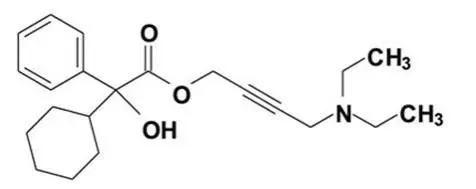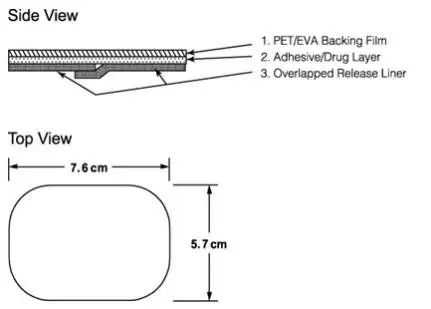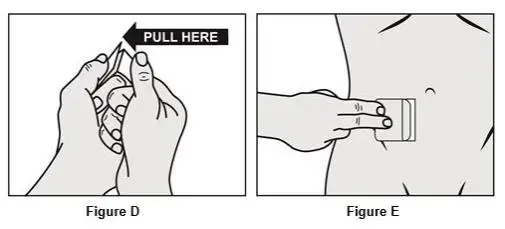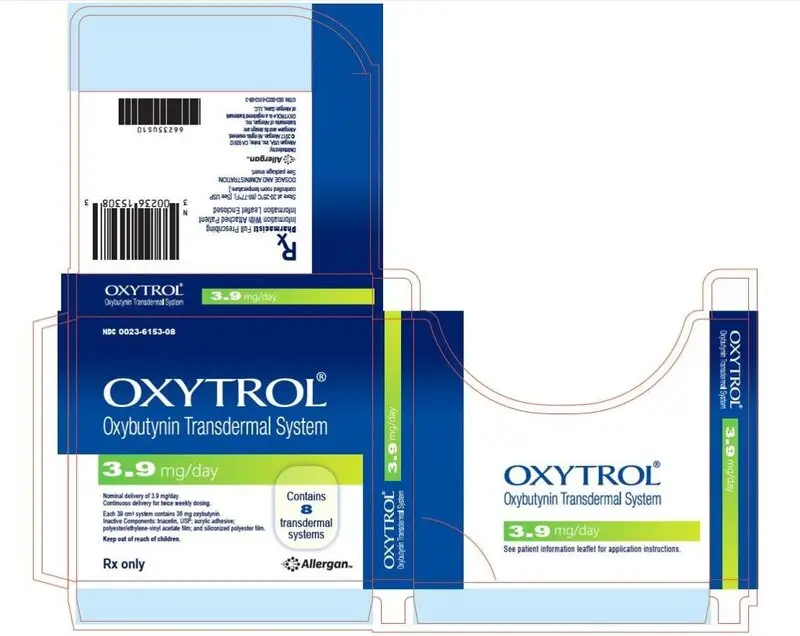Drug Detail:Oxytrol patch (Oxybutynin (transdermal) [ ox-i-bue-ti-nin ])
Drug Class: Urinary antispasmodics
Highlights of Prescribing Information
OXYTROL® (oxybutynin transdermal system)
Initial U.S. Approval: 1975
Indications and Usage for Oxytrol
OXYTROL is a muscarinic antagonist indicated for the treatment of overactive bladder in men with symptoms of urge urinary incontinence, urgency, and frequency. (1)
Oxytrol Dosage and Administration
- Apply OXYTROL transdermal system twice weekly (every 3 to 4 days) to dry, intact skin on the abdomen, hip, or buttocks. (2)
- Select a new application site with each new system to avoid re-application to the same site within 7 days. (2)
Dosage Forms and Strengths
Transdermal system: 3.9 mg/day (3)
Contraindications
- Urinary retention (4)
- Gastric retention (4)
- Uncontrolled narrow-angle glaucoma (4)
- Known serious hypersensitivity reaction to OXYTROL, oxybutynin, or to any of the components of OXYTROL (4)
Warnings and Precautions
- Urinary Retention: Use caution in patients with clinically significant bladder outflow obstruction because of the risk of urinary retention. (5.1)
- Gastrointestinal Disorders: Use caution in patients with gastrointestinal obstructive disorders or decreased intestinal motility because of the risk of gastric retention. Use caution in patients with gastroesophageal reflux and/or those taking drugs that can cause or exacerbate esophagitis. (5.2)
- Central Nervous System Effects: Somnolence has been reported with products containing oxybutynin. Advise patients not to drive or operate heavy machinery until they know how OXYTROL affects them. (5.3)
- Angioedema: Angioedema has been reported with oral oxybutynin use. If symptoms of angioedema occur, discontinue OXYTROL and initiate appropriate therapy. (5.4)
- Skin Hypersensitivity: Discontinue OXYTROL in patients with skin hypersensitivity. (5.5)
- Myasthenia gravis: Avoid use in patients with myasthenia gravis, a disease characterized by decreased cholinergic activity at the neuromuscular junction. (5.6)
Adverse Reactions/Side Effects
The most common adverse reactions (incidence > 5% and > placebo) are application site reactions and dry mouth. (6.1)
To report SUSPECTED ADVERSE REACTIONS, contact Allergan at 1-800-678-1605 or contact the FDA at 1-800-FDA-1088 or www.fda.gov/medwatch
Drug Interactions
Other Anticholinergics (muscarinic antagonists): Concomitant use with other anticholinergic agents may increase the frequency and/or severity of dry mouth, constipation, blurred vision, and other anticholinergic pharmacological effects. (7.1)
See 17 for PATIENT COUNSELING INFORMATION and FDA-approved patient labeling.
Revised: 10/2017
Related/similar drugs
oxybutynin, Myrbetriq, phenazopyridine, Pyridium, solifenacin, tolterodine, mirabegronFull Prescribing Information
1. Indications and Usage for Oxytrol
OXYTROL is a muscarinic antagonist indicated for the treatment of overactive bladder in men with symptoms of urge urinary incontinence, urgency, and frequency.
2. Oxytrol Dosage and Administration
OXYTROL 3.9 mg/day should be applied to dry, intact skin on the abdomen, hip, or buttock twice weekly (every 3 or 4 days). A new application site should be selected with each new system to avoid re-application to the same site within 7 days.
4. Contraindications
The use of OXYTROL is contraindicated in the following conditions:
- Urinary retention
- Gastric retention
- Uncontrolled narrow-angle glaucoma
- Known serious hypersensitivity reaction to OXYTROL, oxybutynin, or to any of the components of OXYTROL [see Warnings and Precautions (5.5)].
5. Warnings and Precautions
5.1 Urinary Retention
Administer OXYTROL with caution in patients with clinically significant bladder outflow obstruction because of the risk of urinary retention [see Contraindications (4)].
5.2 Risks in Patients with Gastrointestinal Disorders
Administer OXYTROL with caution to patients with gastrointestinal obstructive disorders because of the risk of gastric retention [see Contraindications (4)].
OXYTROL, like other anticholinergic drugs, may decrease gastrointestinal motility and should be used with caution in patients with conditions such as ulcerative colitis or intestinal atony.
OXYTROL should be used with caution in patients who have hiatus hernia/gastroesophageal reflux and/or who are concurrently taking drugs (such as bisphosphonates) that can cause or exacerbate esophagitis.
5.3 Central Nervous System Effects
Products containing oxybutynin are associated with anticholinergic central nervous system (CNS) effects. A variety of CNS anticholinergic effects have been reported, including headache, dizziness, somnolence, confusion and hallucinations [see Adverse Events (6.2, 6.3)]. Patients should be monitored for signs of anticholinergic CNS effects, particularly after beginning treatment. Advise patients not to drive or operate heavy machinery until they know how OXYTROL affects them. If a patient experiences anticholinergic CNS effects, drug discontinuation should be considered.
5.4 Angioedema
Angioedema requiring hospitalization and emergency medical treatment has occurred with the first or subsequent doses of oral oxybutynin. In the event of angioedema, OXYTROL should be discontinued and appropriate therapy promptly provided.
5.5 Skin Hypersensitivity
Patients who develop skin hypersensitivity to OXYTROL should discontinue drug treatment.
5.6 Exacerbation of Symptoms of Myasthenia Gravis
Avoid use of OXYTROL in patients with myasthenia gravis, a disease characterized by decreased cholinergic activity at the neuromuscular junction. If experiencing exacerbation of symptoms of myasthenia gravis, oxybutynin-containing product should be discontinued and appropriate therapy promptly provided.
6. Adverse Reactions/Side Effects
6.1 Clinical Trials Experience
Because clinical trials are conducted under widely varying conditions, adverse reaction rates observed in the clinical trials of a drug cannot be directly compared to rates in the clinical trials of another drug and may not reflect the rates observed in clinical practice.
The safety of OXYTROL was evaluated in a total of 417 patients who participated in two clinical efficacy and safety studies and an open-label extension. Additional safety information was collected in earlier phase trials. In the two pivotal studies, a total of 246 patients received OXYTROL during the 12-week treatment periods. A total of 411 patients entered the open-label extension and of those, 65 patients and 52 patients received OXYTROL for at least 24 weeks and at least 36 weeks, respectively.
No deaths were reported during treatment. No serious adverse events related to treatment were reported.
Adverse reactions reported in the pivotal trials are summarized in Tables 1 and 2 below.
| Adverse Reaction |
Placebo (N = 132) | OXYTROL (3.9 mg/day)
(N = 125) |
||
| N | % | N | % | |
| Application site pruritus | 8 | 6.1% | 21 | 16.8% |
| Dry mouth | 11 | 8.3% | 12 | 9.6% |
| Application site erythema | 3 | 2.3% | 7 | 5.6% |
| Application site vesicles | 0 | 0.0% | 4 | 3.2% |
| Diarrhea | 3 | 2.3% | 4 | 3.2% |
| Dysuria | 0 | 0.0% | 3 | 2.4% |
| Adverse Reaction
|
Placebo (N = 117) | OXYTROL (3.9 mg/day)
(N = 121) |
||
| N | % | N | % | |
| Application site pruritus | 5 | 4.3% | 17 | 14.0% |
| Application site erythema | 2 | 1.7% | 10 | 8.3% |
| Dry mouth | 2 | 1.7% | 5 | 4.1% |
| Constipation | 0 | 0.0% | 4 | 3.3% |
| Application site rash | 1 | 0.9% | 4 | 3.3% |
| Application site macules | 0 | 0.0% | 3 | 2.5% |
| Abnormal vision | 0 | 0.0% | 3 | 2.5% |
Most adverse reactions were described as mild or moderate in intensity. Severe application site reactions were reported by 6.4% of OXYTROL-treated patients in Study 1 and by 5.0% of OXYTROL-treated patients in Study 2.
Adverse reactions that resulted in discontinuation were reported by 11.2% of OXYTROL-treated patients in Study 1 and 10.7% of OXYTROL-treated patients in Study 2. Most of these discontinuations were due to application site reaction. In the two pivotal studies, no patient discontinued OXYTROL treatment due to dry mouth.
In the open-label extension, the most common treatment-related adverse reactions were: application site pruritus, application site erythema, and dry mouth.
In a controlled clinical trial of skin sensitization, none of the 103 test subjects demonstrated skin hypersensitivity to OXYTROL.
7. Drug Interactions
No specific drug-drug interaction studies have been performed with OXYTROL.
7.1 Other Anticholinergics
The concomitant use of OXYTROL with other anticholinergic drugs, or with other agents that produce dry mouth, constipation, somnolence, and/or other anticholinergic-like effects may increase the frequency and/or severity of such effects. Anticholinergic agents may potentially alter the absorption of some concomitantly administered drugs due to anticholinergic effects on gastrointestinal motility.
12. Oxytrol - Clinical Pharmacology
12.3 Pharmacokinetics
Absorption
Oxybutynin is transported across intact skin and into the systemic circulation by passive diffusion across the stratum corneum. The average daily dose of oxybutynin absorbed from the 39 cm2 OXYTROL system is 3.9 mg. The average (SD) nominal dose, 0.10 (0.02) mg oxybutynin per cm2 surface area, was obtained from analysis of residual oxybutynin content of systems worn over a continuous 4-day period during 303 separate occasions in 76 healthy volunteers. Following application of the first OXYTROL 3.9 mg/day system, oxybutynin plasma concentrations increase for approximately 24 to 48 hours, reaching average maximum concentrations of 3 to 4 ng/mL. Thereafter, steady concentrations are maintained for up to 96 hours. Absorption of oxybutynin is bioequivalent when OXYTROL is applied to the abdomen, buttocks, or hip. Average plasma concentrations measured during a randomized, crossover study of the three recommended application sites in 24 healthy men and women are shown in Figure 2.
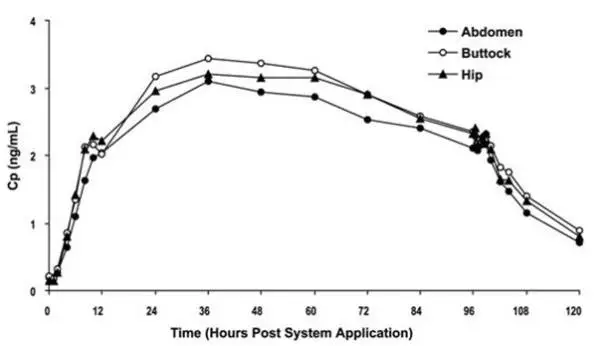
Figure 2: Average plasma oxybutynin concentrations (Cp) in 24 healthy male and female volunteers during single-dose application of OXYTROL 3.9 mg/day to the abdomen, buttock, and hip (System removal at 96 hours).
Steady-state conditions are reached during the second OXYTROL application. Average steady-state plasma concentrations were 3.1 ng/mL for oxybutynin and 3.8 ng/mL for N-desethyloxybutynin (Figure 3). Table 3 provides a summary of pharmacokinetic parameters of oxybutynin in healthy volunteers after single and multiple applications of OXYTROL.
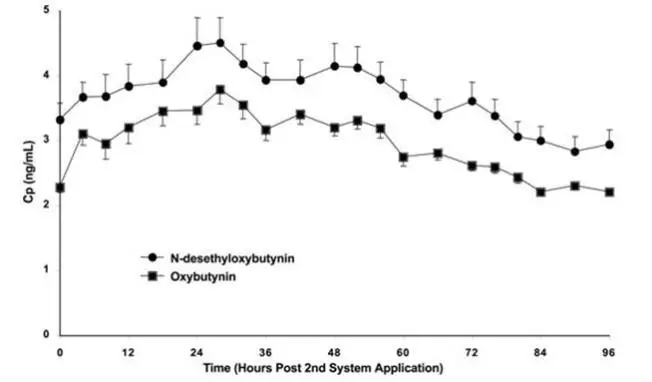
Figure 3: Average (SEM) steady-state oxybutynin and N-desethyloxybutynin plasma concentrations (Cp) measured in 13 healthy volunteers following the second transdermal system application in a multiple-dose, randomized, crossover study.
| Dosing | Oxybutynin | |||
| Cmax (SD)
(ng/mL) | Tmax ‡
(hr) | Cavg (SD)
(ng/mL) | AUC (SD)
(ng/mLxh) |
|
| Single | 3.0 (0.8) | 48 | - | 245 (59)§ |
| 3.4 (1.1) | 36 | - | 279 (99)§ | |
| Multiple | 6.6 (2.4) | 10 | 4.2 (1.1) | 408 (108)¶ |
| 4.2 (1.0) | 28 | 3.1 (0.7) | 259 (57)#Þ | |
‡ Tmax given as median
§ AUCinf
¶ AUC0-96
#Þ AUC0-84
Distribution
Oxybutynin is widely distributed in body tissues following systemic absorption. The volume of distribution was estimated to be 193 L after intravenous administration of 5 mg oxybutynin chloride.
Metabolism
Oxybutynin is metabolized primarily by the cytochrome P450 enzyme systems, particularly CYP3A4, found mostly in the liver and gut wall. Metabolites include phenylcyclohexylglycolic acid, which is pharmacologically inactive, and N-desethyloxybutynin, which is pharmacologically active.
After oral administration of oxybutynin, pre-systemic first-pass metabolism results in an oral bioavailability of approximately 6% and higher plasma concentration of the N-desethyl metabolite compared to oxybutynin (see Figure 4). The plasma concentration area under the time-concentration curve (AUC) ratio of N-desethyl metabolite to parent compound following a single 5 mg oral dose of oxybutynin chloride was 11.9:1.
Transdermal administration of oxybutynin bypasses first-pass gastrointestinal and hepatic metabolism, reducing the formation of the N-desethyl metabolite (see Figure 4). Only small amounts of CYP3A4 are found in skin, limiting pre-systemic metabolism during transdermal absorption. The resulting plasma concentration AUC ratio of N-desethyl metabolite to parent compound following multiple OXYTROL applications was 1.3:1.
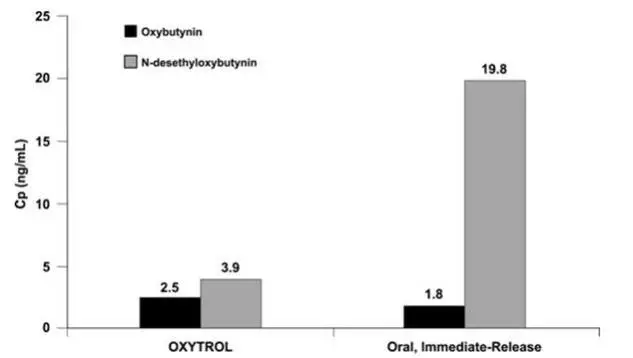
Figure 4: Average plasma concentrations (Cp) measured after a single, 96-hour application of the OXYTROL 3.9 mg/day system (AUCinf/96) and a single, 5 mg, oral immediate-release dose of oxybutynin chloride (AUCinf/8) in 16 healthy male and female volunteers.
Following intravenous administration, the elimination half-life of oxybutynin is approximately 2 hours. Following removal of OXYTROL, plasma concentrations of oxybutynin and N-desethyloxybutynin decline with an apparent half-life of approximately 7 to 8 hours.
Excretion
Oxybutynin is extensively metabolized by the liver, with less than 0.1% of the administered dose excreted unchanged in the urine. Also, less than 0.1% of the administered dose is excreted as the metabolite N-desethyloxybutynin.
Specific Populations:
Geriatric: The pharmacokinetics of oxybutynin and N-desethyloxybutynin were similar in older and younger patients.
Pediatric: The pharmacokinetics of oxybutynin and N-desethyloxybutynin were not evaluated in individuals younger than 18 years of age.
Gender: There were no significant differences in the pharmacokinetics of oxybutynin in healthy male and female volunteers following application of OXYTROL.
Race: Available data suggest that there are no significant differences in the pharmacokinetics of oxybutynin based on race in healthy volunteers following administration of OXYTROL. Japanese volunteers demonstrated a somewhat lower metabolism of oxybutynin to N-desethyloxybutynin compared to Caucasian volunteers.
FDA-approved patient labeling
PATIENT INFORMATION
OXYTROL (OKSEE TROLE)
(oxybutynin transdermal system)
Read this Patient Information before you start taking OXYTROL and each time you get a refill. There may be new information. This information does not take the place of talking with your doctor about your medical condition or your treatment.
What is OXYTROL?
OXYTROL is a transdermal system (skin patch) for the treatment of overactive bladder in men with symptoms of urge urinary incontinence, urgency, and frequency. It delivers the active ingredient, oxybutynin, directly into your bloodstream through your skin.
Overactive bladder makes it hard to urinate (passing water). Overactive bladder can make you urinate more often (increased frequency) or make you feel the need to urinate often (urgency). Overactive bladder can also lead to accidental urine loss (leaking or wetting oneself).
The active ingredient in OXYTROL, oxybutynin, is dissolved in the thin layer of adhesive that sticks the patch to your skin. OXYTROL delivers the medicine slowly and constantly through your skin and into your bloodstream for the 3 or 4 days that you wear the patch. OXYTROL contains the same active ingredient as oxybutynin tablets and syrup.
It is not known if OXYTROL is safe and effective in children.
Who should not use OXYTROL?
Do not use OXYTROL if you have the following medical conditions:
-
Urinary retention. Your bladder does not empty or does not empty completely when you urinate.
-
Gastric retention. Your stomach empties slowly or incompletely after a meal.
-
Uncontrolled narrow-angle glaucoma (high pressure in your eye). Tell your doctor if you have glaucoma or a family history of glaucoma.
- Allergy to oxybutynin or the inactive ingredients in OXYTROL. If you are allergic to oxybutynin or any of the ingredients in OXYTROL. See the end of this leaflet for a complete list of ingredients in OXYTROL. If you have allergies to medical tape products or other skin patches, tell your doctor.
What should I tell my doctor before using OXYTROL?
Before you take OXYTROL, tell your doctor if you:
- have liver problems
- have kidney problems
- have problems emptying your bladder completely
- have a gastrointestinal obstruction (blockage in the digestive system)
- have ulcerative colitis (inflamed bowels)
- have gastric reflux disease or esophagitis (inflamed esophagus, the tube between your mouth and stomach)
- have Myasthenia Gravis (generalized muscle weakness)
- are pregnant or plan to become pregnant. It is not known if OXYTROL will harm your unborn baby.
- are breastfeeding or plan to breastfeed. It is not known if OXYTROL passes into your breast milk. You and your doctor should decide if you will take OXYTROL or breastfeed.
Tell your doctor about all the medicines you take, including prescription and non-prescription medicines and herbal supplements.
Using OXYTROL with certain other medicines may affect each other. Using OXYTROL with other medicines can cause serious side effects.
Especially tell your doctor if you take:
- medicines called “bisphosphonates” to treat osteoporosis
- medicines called “anticholinergics”
Ask your doctor or pharmacist for a list of these medicines if you are not sure if this is your medicine.
Know the medicines you take. Keep a list of them and show it to your doctor and pharmacist when you get a new medicine.
How should I use OXYTROL?
- Read the Instructions for Use at the end of this Patient Information Leaflet for information on the right way to use OXYTROL.
- Use OXYTROL exactly as your doctor tells you to use it.
- Put on a new patch of OXYTROL 2 times a week (every 3 to 4 days) according to your doctor’s instructions.
- Choose a new skin site for each new patch application. You should not use the same skin site within 7 days.
- Wear the patch all the time until it is time to apply a new one.
- Wear only 1 patch of OXYTROL at a time.
- Try to change the patch on the same 2 days each week.
- Your package of OXYTROL has a calendar checklist printed on the back to help you remember your schedule. Mark the schedule you plan to follow. Always change OXYTROL on the 2 days of the week you mark on the calendar.
- Contact with water when you are bathing, swimming, showering or exercising will not change the way that OXYTROL works.
What should I avoid while using OXYTROL?
- You should not drink alcohol while using OXYTROL. It can increase your chance of getting serious side effects.
- OXYTROL can cause dizziness or blurred vision. Do not drive or operate machinery, or do other dangerous activities until you know how OXYTROL affects you.
-
Do not put OXYTROL on areas that have been treated with oils, lotions, or powders that could keep the patch from sticking well to your skin. Do not expose the patch to sunlight. Wear your patch under clothing.
- Avoid rubbing the patch area during bathing, swimming, showering or exercising.
What are the possible side effects of OXYTROL?
OXYTROL may cause serious side effects, including:
-
inability to empty your bladder (urinary retention). OXYTROL may increase your chances of not being able to empty your bladder if you have bladder outlet obstruction. Tell your doctor right away if you are unable to empty your bladder.
-
increased risk of stomach problems in certain patients. OXYTROL may cause stomach problems in patients who have a history of ulcerative colitis, intestinal atony, gastrointestinal reflux, or who are taking certain medicines called bisphosphonates.
-
central nervous system effects. OXYTROL can cause central nervous system effects including headache, dizziness, and sleepiness. Your doctor should monitor you for these effects after starting OXYTROL. See “What should I avoid while using OXYTROL.”
-
swelling (angioedema). The active ingredient in OXYTROL, oxybutynin, can cause swelling around the eyes, lips, genitals, hands or feet. Some people who have taken oxybutynin medicines by mouth have had to be hospitalized. Stop using OXYTROL immediately and seek emergency treatment right away if you have any of these symptoms.
-
skin hypersensitivity. You may have skin changes where the patch was placed such as itching, rash, or redness. Tell your doctor if these changes do not go away or bother you.
- worsening of myasthenia gravis. OXYTROL can make symptoms worse in people who have myasthenia gravis. See “What should I tell my doctor before using OXYTROL?”
The most common side effects of OXYTROL include skin reactions where the patch is placed and dry mouth.
Since oxybutynin treatment may decrease sweating, you may overheat or have fever or heat stroke if you are in warm or hot temperatures.
Tell your doctor if you have any side effect that bothers you or that does not go away or if you have constipation.
These are not all the side effects of OXYTROL. For a complete list, ask your doctor or pharmacist.
Call your doctor for medical advice about side effects. You may report side effects to FDA at 1-800-FDA-1088.
How should I store OXYTROL?
- Store OXYTROL at 68°F to 77°F (20°C to 25°C).
- Do not store OXYTROL outside the sealed pouch.
- Keep OXYTROL patches in a dry place.
Keep OXYTROL and all medicines out of the reach of children.
General information about the safe and effective use of OXYTROL.
Medicines are sometimes prescribed for purposes other than those listed in a Patient Information Leaflet. Do not use OXYTROL for a condition for which it was not prescribed. Do not give OXYTROL to other people, even if they have the same symptoms you have. It may harm them.
This Patient Information Leaflet summarizes the most important information about OXYTROL. If you would like more information, talk with your doctor. You can ask your doctor or pharmacist for information about OXYTROL that is written for health professionals.
For more information, go to www.OXYTROL.com website or call 1-800-678-1605.
What are the ingredients of OXYTROL?
Active Ingredient: oxybutynin
Inactive Ingredients: Flexible polyester/ethylene-vinyl acetate film, acrylic adhesive, triacetin, siliconized polyester film.
| OXYTROL
oxybutynin patch |
|||||||||||||||||||||||||
|
|||||||||||||||||||||||||
|
|||||||||||||||||||||||||
|
|||||||||||||||||||||||||
|
|||||||||||||||||||||||||
|
|||||||||||||||||||||||||
|
|||||||||||||||||||||||||
| Labeler - Allergan, Inc. (144796497) |




